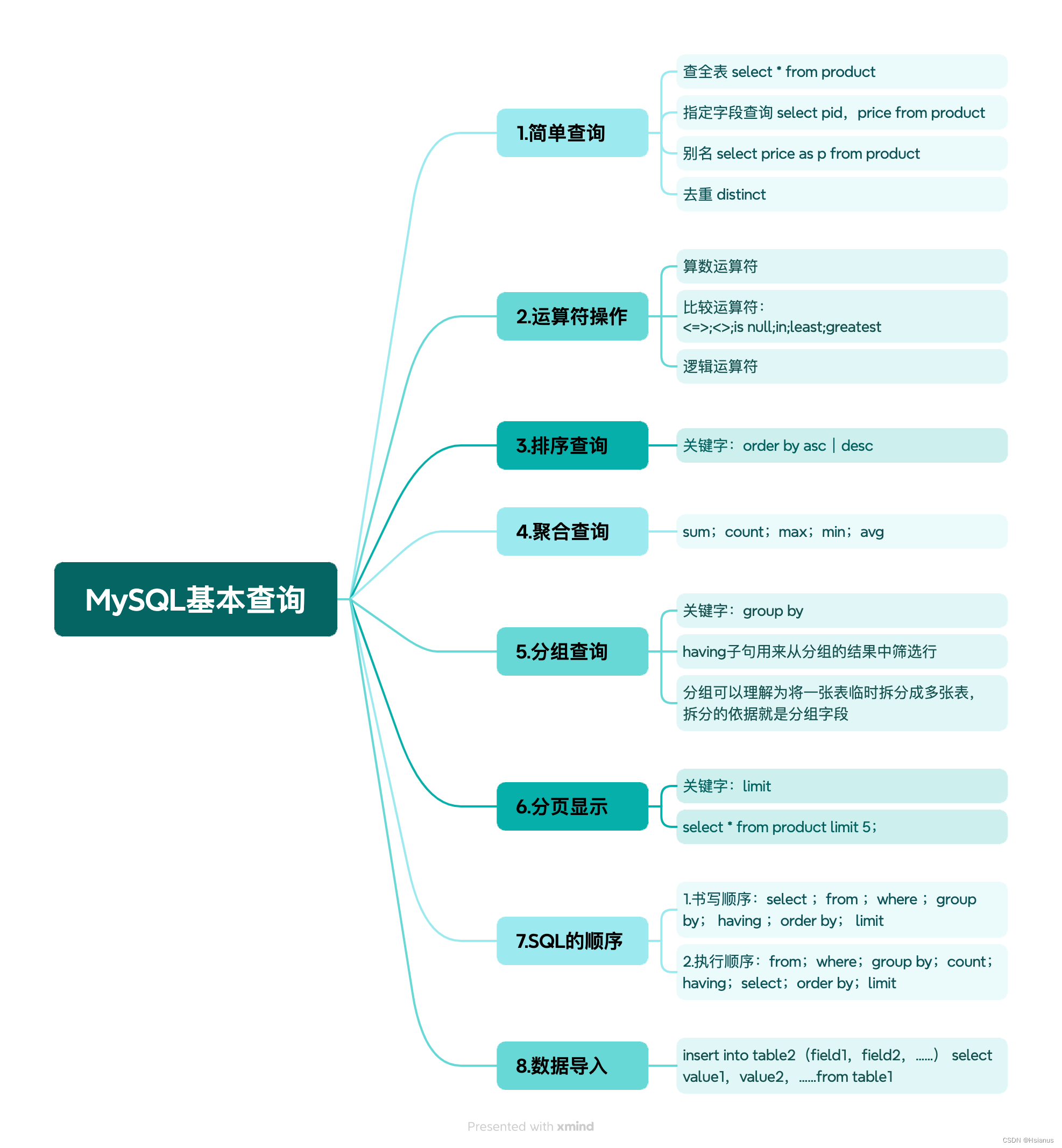一.概念
数据查询不应只是简单返回数据库中存储的数据,还应该根据需要对数据进行筛选以及确定数据以什么样的格式显示。
二.语法格式
select 列名 from 表 where 条件
1.查询所有的商品
select * from product;2.查询商品名和商品价格
select pname,price from product;3.别名查询
使用关键字as,as可以省略
表别名:
select * from product as p;
select * from product p;列别名:
select pname as '商品名',price as '商品价格' from product;4.去掉重复值
select distinct price from product;5.运算查询
select pname,price+10 from product;三.运算符
1.算数运算符
+ - * / %
2.比较运算符
1)<=>
安全的等于,两个操作数均为null时,其所得值为1;当一个操作数为null时,其所得值为0.
2)<> 或!=
不等于
3)IS NULL或ISNULL
判断一个值是否为NULL
4)IS NOT NULL
5)LEAST
返回最小值
6)GREATEST
返回最大值
7)BETWEEN AND
判断一个值是否落在两个值之间
8)IN
判断一个值是列表中的任意一个值
9)NOT IN
10)LIKE
通配符匹配
11)REGEXP
正则表达式匹配
注:
1)通配符是一种特殊语句,主要有星号(*)和问号(?),用来模糊搜索文件。当查找文件夹时,可以使用它来代替一个或多个真正字符;当不知道真正字符或者懒得输入完整名字时,常常使用通配符代替一个或多个真正的字符。
2)正则表达式,又称规则表达式,(Regular Expression,在代码中常简写为regex、regexp或RE),是一种文本模式,包括普通字符(例如,a 到 z 之间的字母)和特殊字符(称为"元字符"),是计算机科学的一个概念。正则表达式使用单个字符串来描述、匹配一系列匹配某个句法规则的字符串,通常被用来检索、替换那些符合某个模式(规则)的文本。
3.逻辑运算符
1)NOT或!
逻辑非
2)AND或&&
逻辑与
3)OR或||
逻辑或
4)XOR
逻辑异或
四.运算符的应用
1.算数运算符
select pname,price+10 as new_price from product;2.比较运算符/逻辑运算符
select * from product where pname='海尔洗衣机';select * from product where price=800; select * from product where price in (200,800);select * from product where pname like '%裤%';%用来匹配任意字符
select * from product where pname like '_%蔻';_下划线匹配单个字符
select * from product where category_id is null;不能够使用=,因为null不等于任何值。
求最小值和最大值时,如果有一个值为null,则不进行比较,结果直接为null。
五.排序查询
对读取的数据进行排序,使用order by语句
语法格式:
select
字段名1,字段名2,……
from 表名
order by 字段名1 [asc,desc],字段名2 [asc,desc]
asc表示升序,desc表示降序,默认升序
order by 子句,放在查询语句的最后面。limit子句除外
select * from product order by price desc;select * from product order by price desc , category_id desc;select distinct price from product order by price desc;六.聚合查询
之前我们做的查询都是横向查询,而聚合查询是对一列的值进行计算,返回一个值。
1.查询商品的总条数
select count(pid) from product;select count(*) from product;查询所有记录不为空的条数
select count(pid) from product where price>200;2.查询总和
select sum(price) from product where category_id='c001';3.查询最大/最小价格
select max(price) from product;
select min(price) from product;4.查询平均价格
select avg(price) from product where category_id='c002';5.聚合查询对于null的处理
1.count函数对null值的处理
如果count函数的参数为*,则统计所有记录的个数。如果参数为某字段,则不统计含null值的记录个数。
2.sum/avg/max/min对null值的处理
忽略null值的存在
七.分组查询(group by)
对查询信息进行分组
select category_id,count(id) from product group by category_id;分组之后,select后面只能写分组字段和聚合函数。
分组之后的条件筛选——having
分组之后对统计结果进行筛选不能够使用where
having子句用来从分组的结果中筛选行。
select category_id,count(id) cnt from product group by category_id having cnt>4;SQL的执行顺序
from ->group by ->count ->select ->having ->order by
八.分页查询(limit)
采用分页显示方式。
limit m,n
m:整数,表示从第几条索引开始
n:整数,表示查询多少条数据
select * from product limit 5;显示前5条
select * from product limit 3,5;从第四条开始显示,显示5条。
九.数据导入
将一张表的数据导入到另一张表中
格式;
insert into table2 select * from table1
要求目标表2必须存在。
insert into product3 select category_id , count(*) from product group by category_id;十.总结










)



用来计算组合数,也能返回从向量v中抽取k个元素的所有组合)
, 贪心算法2)
理论)
:神经网络之NLP基础—词向量)


